Canada thistle (commonly referred to as creeping thistle) is a perennial weed that grows in a wide variety of climates and soil conditions, making it a real problem for homeowners in our area. It looks very similar to any other type of thistle or wildflower, but it spreads much more rapidly and develops deep taproots. Their presence in your lawn is nearly impossible to miss once you know what to look for, and you want to deal with them as early as possible to keep your grass healthy. Fortunately, this post will explain how to both identify and control Canada thistle before it's too late!
Identifying Canada Thistle

Canada/creeping thistle (Cirsium arvense) is a unique-looking lawn weed that ruins the aesthetic of any lawn it finds its way onto. Its most notable characteristic is its pink-to-purple flower heads that develop in clusters. These flowers have an unusual appearance that is often said to resemble sharp strands or spikes, which is what makes them so easy to identify in gardens and lawns. The disk flowers emerge from egg- or bell-shaped flower heads covered in spines.
Stems can grow up to 5 feet tall in ideal conditions, and they are either hairless or nearly hairless. Leaves of Canada thistle are lance-shaped and prickly, and they can be more easily identified by their toothed edges. The leaves grow up the spine in alternate pairs, and they can help identify this weed before the flowers develop. When pulled up from the soil, you can also identify Canada thistle by its horizontal rhizomes (underground stems) that emerge from a central taproot; other types of thistles do not always have these horizontal rhizomes.
Kay Characteristics:
-Purple or pink flowers
-Egg- or bell-shaped flower head
-Slender, hairless stems
-Prickly leaves in alternate pairs
-Taproots with horizontal rhizomes
-Clumping/bunching growth pattern
Does Canada Thistle Kill Grass?
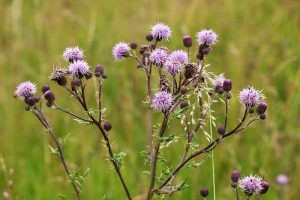
Canada thistle is considered a noxious weed that will harm the surrounding vegetation. It secretes chemicals from its extensive root system that are toxic to other plants, including the grass in your lawn. The rhizomes of the root system are also a problem in lawns and gardens because of their invasive nature. As they grow and spread horizontally, they will start to overtake and damage the roots of your grass or plants.
Canada thistle is also notoriously thirsty! This weed has high moisture requirements, and it has the ability to access water before desired vegetation can. Though the taproot of Canada thistle can grow up to 6 feet deep in the soil, the majority of the root structure exists only a few inches below the soil surface. These shallower parts of the roots enable the weed to absorb moisture and nutrients more quickly, and there will be few resources left to sustain your lawn. If left unchecked, Canada thistle will severely deplete and even kill your grass.
When & Where Does Canada Thistle Grow?
Wh
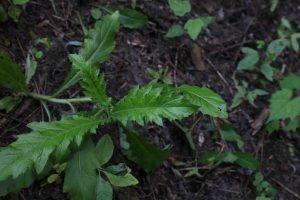
en: Canada/creeping thistle is a perennial broadleaf weed, meaning it will keep coming back each year until the plant is removed. It is most active in our region between the months of June and October. It is within this timeframe that you are most likely to see the unique, colorful flowers that this weed produces. Seedlings will emerge in small rosette patterns in late fall or early spring. When the weather is warm enough, the weed will begin to grow upright until the flower head is produced and seeds can be distributed, which will begin the life cycle again.
Where: As the name would suggest, Canada thistle can commonly be found in Canada and the northwestern United States, like Oregon and Washington, but it can grow virtually anywhere if temperatures are warm enough. It is known to pop up along roadsides and in open fields, but it is not uncommon to find it right in your own backyard. Wetlands and areas near bodies of water are especially vulnerable due to the moisture requirements of Canada thistle. When it comes to residential areas, lawns and yards with drainage issues that produce standing water are prime real estate for this weed.
How Does Canada Thistle Spread?
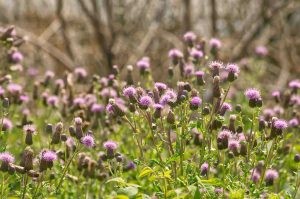
As a true perennial, Canada thistle spreads by both seeds and roots to make its presence long-lasting and dominant for many years. The seed head of this weed is a very light, feathery tuft that is loosely attached to the stem. These characteristics allow seed dispersal to take place very easily, often by simple wind dispersal or even the slightest physical disturbance. Seeds can be carried long distances on air currents, and they can remain viable in the soil for many years once they find a home. A single plant typically produces between 1,000 and 1,5000 seeds, but some may be capable of producing upwards of 5,000 seeds in rare cases.
This weed is called creeping thistle for a reason... it creeps! In addition to seed dispersal, the underground rhizomes also help spread a Canada thistle invasion. The horizontal roots spread outward and sprout new growth, which means another plant to disperse seeds and ravage your yard. The roots enter a state of dormancy in colder weather, and they simply pick up right where they left off when the weather warms up in the following spring. Even if you try to remove Canada thistle, the smallest fragments of roots left in the soil can sprout new growth, which is why proper control methods are so important.
Controlling Canada Thistle

Now that you have identified and learned about Canada thistle, it's time to take action! Hand pulling is sometimes an option if the population of this weed is small, but be sure to wear thick gloves as the prickly leaves could sting you. Try to remove as much of the root system as possible so that regrowth does not occur. You can also use a gardening spade to dig up larger patches of these weeds; however, this method requires more labor and expertise in order to remove the entire root structure, but it is the best way to ensure the plant is fully removed.
Herbicides containing glyphosate or triclopyr are effective in controlling Canada/creeping thistle when used as directed on the label. Herbicides are most effective when applied at full bloom, or at least once the flowers start to bud; applying these chemicals before this time will not have the intended result.
Most importantly, keep your lawn healthy! Lawn care tasks like aeration and fertilization help ensure that your lawn is not retaining excess water, which is exactly the kind of environment Canada thistle requires. For the best lawn care and weed control efforts, turn to the professionals like the ones here at Simple Lawns! Our team knows what lawns need to stay lush and weed free, so give us a call today for a free quote, and get your yard one step closer to perfection!
Subscribe to Simple Lawns's Blog




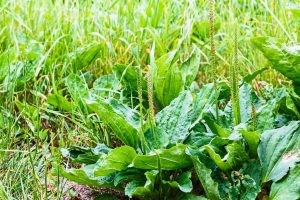

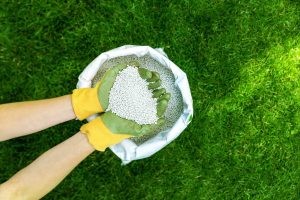


Comments